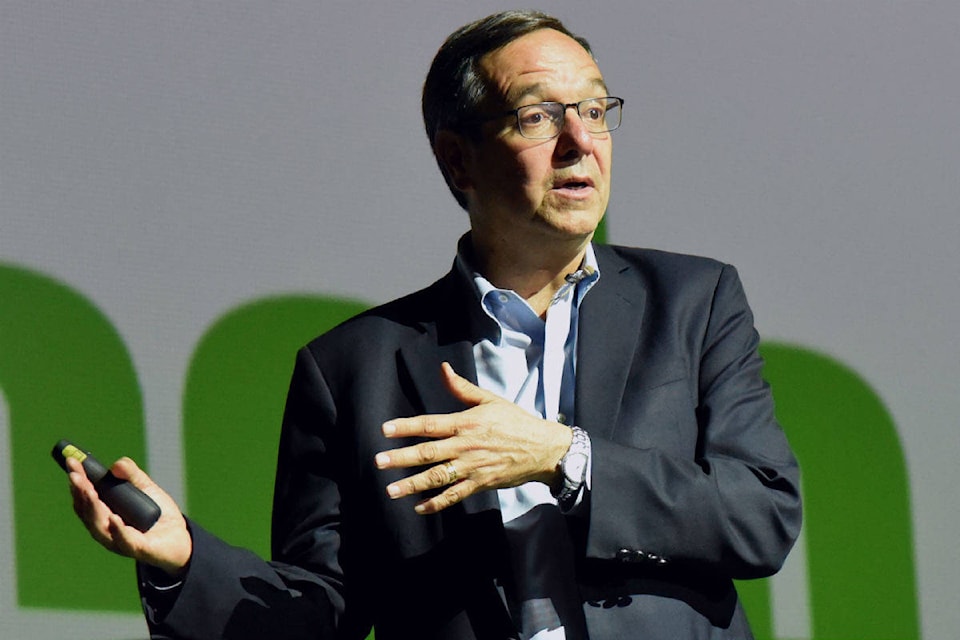The Cowichan Valley should invest in creating walkable, dynamic, green cities if it wants to enhance sociability and retrofit to be a place where both young children and seniors can thrive alongside each other, says world-renowned urban planning consultant Gil Penalosa.
“What if everything we did had to be great for both an eight-year-old and 80-year-old,” he said. “Here in the Cowichan Valley you have to benchmark with the best….every morning you should wake up and ask how do we attract the best people.”
Penalosa is the founder and chair of 8 80 Cities, a non-profit promoting exactly the described vision, and has worked with 200 municipalities worldwide on how to create healthy, vibrant and sustainable communities.
He is in Cowichan this week, meeting with secondary school students as well as local government officials, and on Tuesday night was the latest speaker in the Place-Making Vancouver Island series organized by the CVRD.
Penalosa spoke for over an hour about how Cowichan can change for the better - a simple recipe of eight steps that may involve a culture shift for some at first, but of course “change is not unanimous, there will always be a concern.”
“There are so many things that you can do in a small community that are so magnificent,” he told the engaged audience at the Cowichan Performing Arts Centre.
Penalosa’s bold vision encourages local communities to build play areas all over a community that are within a 10 minute walk for children.
“We should have playability everywhere in the valley,” he said, adding that green spaces with sitting areas creates the type of sociability that builds communities. “It’s not just about the community centres and the indoor spaces, we need to get people outside - the most important feature of any park is a walking path.”
Municipalities need parks that are small, medium and large-scale, such as Transfer Beach, because each has different uses, from a quiet place to meet a friend for lunch to a something more capable of holding a concert.
“The small neighbourhood park is where we develop community, where we’re meeting our neighbours, and it also makes our community safer because there’s a sense of solidarity,” he said.
“Once you start organizing it leaders from the community take over and they start organizing it themselves but sometimes you have to deliver a little bit of funding to get those things started.”
But building more parks also isn’t necessarily about finding the space. As Penalosa explained through his extremely visual presentation, great cities around the world have transformed ugly concrete playgrounds into multi-use spaces. If those don’t exist, it’s as simple as closing off a street periodically and letting pedestrians take over, such as with the Light Up, Arts on the Avenue and Show & Shine.
But are children safe to stay after school to play without being under constant supervision ? Penalosa thinks so.
“When you want to have public places that are safe it’s not about police, it’s about people. When you have people in the parks then they are safe,” he said.
There’s also his pitch to lower residential zones to 30 km/h because the pedestrian fatalities dip to only 5 per cent. Motorists killed 741 people walking last year, according to statistics part of the presentation.
“Walking and biking safely should be like a human right,” he said, adding that some schools in Quebec don’t allow parents to drop off children in front of the school to promote walking and safety. “I’ve seen a lot of neighbourhoods here that don’t even have a sidewalk and the bike lanes are just a painted line.”
Cowichan Valley, which will experience a steady stream of growth over the coming decades, also shouldn’t only look to serve and attract 30-something year olds who are athletic, he added.
“The biggest waste of resources that we have developed are the older adults,” he said. “People retire and we cross them out as if they have nothing except that they have 20, 30, 40 years left and they are healthy and worthy and more active…and they could be fantastic assets to a community.”
In closing, Penalosa encouraged more civic engagement to enhance longterm benefits for the environment, economic activity, recreation, transportation, health.
“All of this is about how we want to live. Let’s think outside the box here in Cowichan Valley and do something special,” he said. “This is not a time for citizens to be spectators, we need to be engaged and participate. So anyone who wants a vibrant and healthy Cowichan Valley, when they’re talking about sidewalks, when they’re talking about trees or public transit, you need to be at the table, be at the meetings, sending emails, making phone calls, because if you’re not at the table you’re going to be on the menu.”
